The Fiber Spinning Equipment Market is estimated to be valued at USD 544.2 million in 2025 and is projected to reach USD 805.5 million by 2035, registering a compound annual growth rate (CAGR) of 4.0% over the forecast period.
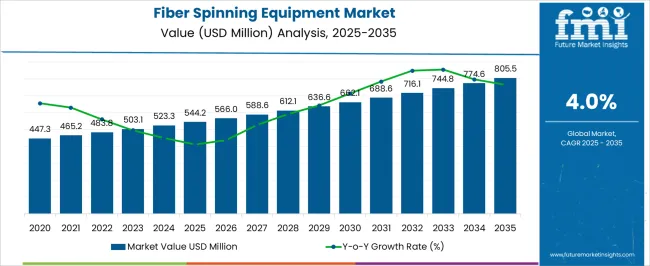
| Metric | Value |
|---|---|
| Fiber Spinning Equipment Market Estimated Value in (2025 E) | USD 544.2 million |
| Fiber Spinning Equipment Market Forecast Value in (2035 F) | USD 805.5 million |
| Forecast CAGR (2025 to 2035) | 4.0% |
The Fiber Spinning Equipment market is witnessing substantial growth due to increasing demand for high-quality fibers in textiles, industrial applications, and advanced composites. The current market is shaped by the adoption of innovative spinning technologies that enhance efficiency, uniformity, and productivity while reducing energy consumption and material waste. Investment in automated and software-assisted fiber spinning systems has further accelerated adoption across both emerging and mature textile markets.
Rising demand for synthetic fibers and specialty fibers in clothing, automotive, and industrial sectors is driving market expansion. Manufacturers are increasingly focusing on integrating environmentally sustainable practices and energy-efficient equipment into their production lines, which is enhancing overall operational performance.
The future outlook indicates continued growth driven by technological advancements, rising labor cost pressures that favor automation, and increased emphasis on high-performance fibers for technical applications Expansion in industrial end uses such as composites, filtration, and high-strength fabrics is expected to open new growth avenues while maintaining robust demand for traditional textile applications.
The fiber spinning equipment market is segmented by spinning type, type, and geographic regions. By spinning type, fiber spinning equipment market is divided into Melt Fiber Spinning Equipment, Wet Fiber Spinning Equipment, Dry Fiber Spinning Equipment, and Gel Fiber Spinning Equipment. In terms of type, fiber spinning equipment market is classified into Electric Fiber Spinning Equipment and Manual Fiber Spinning Equipment. Regionally, the fiber spinning equipment industry is classified into North America, Latin America, Western Europe, Eastern Europe, Balkan & Baltic Countries, Russia & Belarus, Central Asia, East Asia, South Asia & Pacific, and the Middle East & Africa.
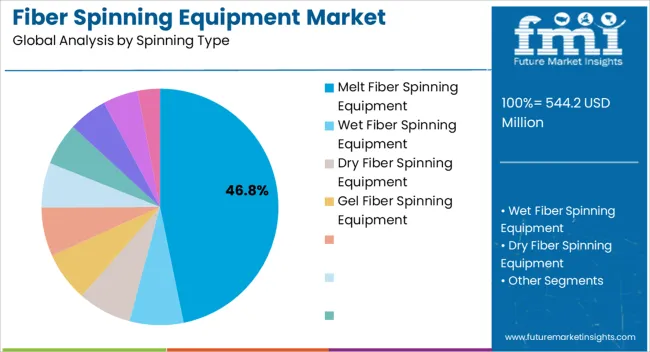
The Melt Fiber Spinning Equipment segment is projected to hold 46.80% of the Fiber Spinning Equipment market revenue in 2025, establishing it as a key technology segment. Growth in this segment has been driven by the efficiency and versatility of melt spinning processes, which allow uniform fiber production at high throughput rates. These systems are widely adopted for producing synthetic fibers such as polyester and polypropylene, which are increasingly used in textiles, industrial materials, and technical applications.
The demand has been supported by the equipment’s ability to deliver consistent fiber diameter, strength, and elongation, critical for both high-volume textile production and specialized technical fibers. Automation and real-time process control have further enhanced the precision and productivity of melt spinning systems, while energy efficiency improvements have reduced operational costs.
Expansion in global fiber demand, coupled with the preference for modular and upgradeable spinning equipment, has reinforced the segment’s position as a leading choice for manufacturers seeking scalable, high-performance solutions Melt spinning equipment continues to benefit from adoption in industries emphasizing quality, consistency, and productivity.
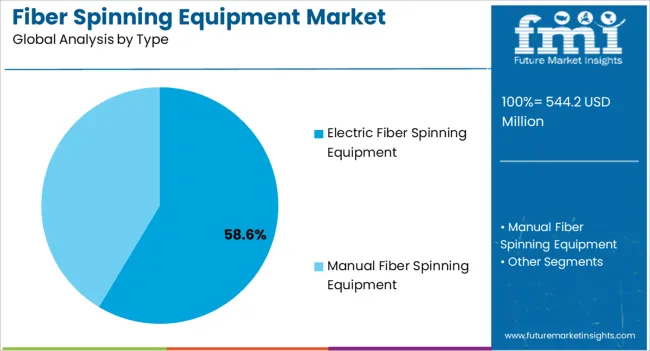
The Electric Fiber Spinning Equipment segment is expected to capture 58.60% of the overall Fiber Spinning Equipment market revenue in 2025, making it the leading technology segment. Growth in this segment is being driven by its precision control, energy efficiency, and adaptability for producing fine and specialty fibers used in high-performance applications.
Electric spinning systems offer advantages in consistent speed regulation, reduced maintenance requirements, and integration with automation platforms, which has supported adoption across both commercial and industrial fiber production. The increasing use of technical fibers for automotive, filtration, medical textiles, and advanced composites has favored the deployment of electric fiber spinning equipment, as it enables accurate control over fiber morphology and properties.
Additionally, manufacturers are leveraging electric spinning systems for faster changeovers and lower energy consumption, making them cost-effective and sustainable The segment’s growth is further reinforced by rising demand for high-quality synthetic fibers and ongoing technological advancements, positioning electric fiber spinning equipment as the preferred choice for modern, scalable, and flexible fiber production operations.
Textiles and their product forms are omnipresent whether in the form of clothes, in offices or to decorate our homes which is derived from spinning, knitting and weaving processes in manufacturing mills. Spinning is an industrial process where a material, for instance natural source/polymer, is made into a bundle called a fiber. In order to convert the natural source/polymer into a fiber, the natural source/polymer must be taken into a process able fluid state.
This can be prepared by dissolving the polymer in an appropriate solvent (spinning solvent) or by melting the polymer. In the event of dissolve spinning, the melt state of fiber-forming material is squeeze out with the help of tiny holes of a spinneret to manufacture continuous filament fiber. There are many types of spinning: dry, wet, dry jet-wet, gel, melt, and electro spinning. Nowadays, spinning involves various methods and different type of machines are used, depending on what kind of yarn is being made.
In the last decade, the textile industry has showed dynamics growth in terms of trends in the global production of textile products. Developing countries, especially in Asian region, are the major textile exporter while the textile industry (in Serbia) is one of the prominent export sectors of the country's economy in spite of the serious development issues brought about by the changeover process. Therefore, it will indirectly support the demand for fiber spinning equipment market.
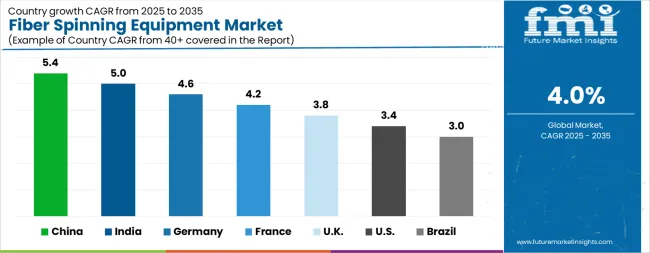
| Country | CAGR |
|---|---|
| China | 5.4% |
| India | 5.0% |
| Germany | 4.6% |
| France | 4.2% |
| UK | 3.8% |
| USA | 3.4% |
| Brazil | 3.0% |
The Fiber Spinning Equipment Market is expected to register a CAGR of 4.0% during the forecast period, exhibiting varied country level momentum. China leads with the highest CAGR of 5.4%, followed by India at 5.0%. Developed markets such as Germany, France, and the UK continue to expand steadily, while the USA is likely to grow at consistent rates. Brazil posts the lowest CAGR at 3.0%, yet still underscores a broadly positive trajectory for the global Fiber Spinning Equipment Market. In 2024, Germany held a dominant revenue in the Western Europe market and is expected to grow with a CAGR of 4.6%. The USA Fiber Spinning Equipment Market is estimated to be valued at USD 190.8 million in 2025 and is anticipated to reach a valuation of USD 266.6 million by 2035. Sales are projected to rise at a CAGR of 3.4% over the forecast period between 2025 and 2035. While Japan and South Korea markets are estimated to be valued at USD 27.0 million and USD 17.5 million respectively in 2025.
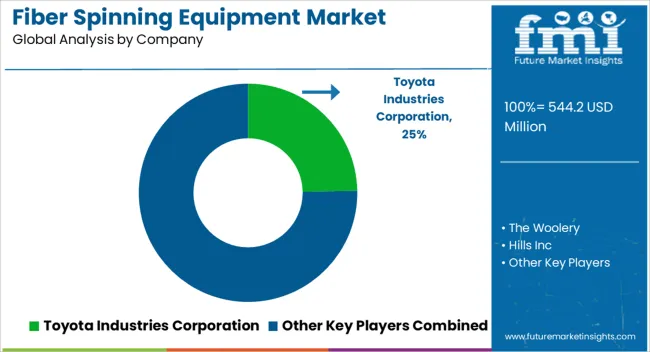
| Item | Value |
|---|---|
| Quantitative Units | USD 544.2 Million |
| Spinning Type | Melt Fiber Spinning Equipment, Wet Fiber Spinning Equipment, Dry Fiber Spinning Equipment, and Gel Fiber Spinning Equipment |
| Type | Electric Fiber Spinning Equipment and Manual Fiber Spinning Equipment |
| Regions Covered | North America, Europe, Asia-Pacific, Latin America, Middle East & Africa |
| Country Covered | United States, Canada, Germany, France, United Kingdom, China, Japan, India, Brazil, South Africa |
| Key Companies Profiled | Toyota Industries Corporation, The Woolery, Hills Inc, Senbis Polymer Innovations BV, Musashino Kikai Co. Ltd, Halcyo Yarn, C. ILLIES & Co. Handelsgesellschaft mbH, Rockwell Automation, and Marzoli Machines Textile Srl |
The global fiber spinning equipment market is estimated to be valued at USD 544.2 million in 2025.
The market size for the fiber spinning equipment market is projected to reach USD 805.5 million by 2035.
The fiber spinning equipment market is expected to grow at a 4.0% CAGR between 2025 and 2035.
The key product types in fiber spinning equipment market are melt fiber spinning equipment, wet fiber spinning equipment, dry fiber spinning equipment and gel fiber spinning equipment.
In terms of type, electric fiber spinning equipment segment to command 58.6% share in the fiber spinning equipment market in 2025.






Our Research Products

The "Full Research Suite" delivers actionable market intel, deep dives on markets or technologies, so clients act faster, cut risk, and unlock growth.

The Leaderboard benchmarks and ranks top vendors, classifying them as Established Leaders, Leading Challengers, or Disruptors & Challengers.

Locates where complements amplify value and substitutes erode it, forecasting net impact by horizon

We deliver granular, decision-grade intel: market sizing, 5-year forecasts, pricing, adoption, usage, revenue, and operational KPIs—plus competitor tracking, regulation, and value chains—across 60 countries broadly.

Spot the shifts before they hit your P&L. We track inflection points, adoption curves, pricing moves, and ecosystem plays to show where demand is heading, why it is changing, and what to do next across high-growth markets and disruptive tech

Real-time reads of user behavior. We track shifting priorities, perceptions of today’s and next-gen services, and provider experience, then pace how fast tech moves from trial to adoption, blending buyer, consumer, and channel inputs with social signals (#WhySwitch, #UX).

Partner with our analyst team to build a custom report designed around your business priorities. From analysing market trends to assessing competitors or crafting bespoke datasets, we tailor insights to your needs.
Supplier Intelligence
Discovery & Profiling
Capacity & Footprint
Performance & Risk
Compliance & Governance
Commercial Readiness
Who Supplies Whom
Scorecards & Shortlists
Playbooks & Docs
Category Intelligence
Definition & Scope
Demand & Use Cases
Cost Drivers
Market Structure
Supply Chain Map
Trade & Policy
Operating Norms
Deliverables
Buyer Intelligence
Account Basics
Spend & Scope
Procurement Model
Vendor Requirements
Terms & Policies
Entry Strategy
Pain Points & Triggers
Outputs
Pricing Analysis
Benchmarks
Trends
Should-Cost
Indexation
Landed Cost
Commercial Terms
Deliverables
Brand Analysis
Positioning & Value Prop
Share & Presence
Customer Evidence
Go-to-Market
Digital & Reputation
Compliance & Trust
KPIs & Gaps
Outputs
Full Research Suite comprises of:
Market outlook & trends analysis
Interviews & case studies
Strategic recommendations
Vendor profiles & capabilities analysis
5-year forecasts
8 regions and 60+ country-level data splits
Market segment data splits
12 months of continuous data updates
DELIVERED AS:
PDF EXCEL ONLINE
Fiber Optic Test Equipment Market Outlook - Size, Share & Forecast 2025 to 2035
Fiber Optic Probe Hydrophone (FOPH) Market Size and Share Forecast Outlook 2025 to 2035
Fiberglass Centrifugal Fan Market Size and Share Forecast Outlook 2025 to 2035
Fiber to the Home Market Size and Share Forecast Outlook 2025 to 2035
Fiber Based Packaging Market Size and Share Forecast Outlook 2025 to 2035
Fiber Lid Market Forecast and Outlook 2025 to 2035
Fiberglass Tanks Market Size and Share Forecast Outlook 2025 to 2035
Fiber Sorter Market Size and Share Forecast Outlook 2025 to 2035
Fiber Reinforced Polymer Panel and Sheet Market Size and Share Forecast Outlook 2025 to 2035
Fiber Optic Tester Market Size and Share Forecast Outlook 2025 to 2035
Fiber Laser Market Size and Share Forecast Outlook 2025 to 2035
Fiberglass Market Size and Share Forecast Outlook 2025 to 2035
Fiber Reinforced Plastic (FRP) Panels & Sheets Market Size and Share Forecast Outlook 2025 to 2035
Fiberglass Fabric Market Size and Share Forecast Outlook 2025 to 2035
Fiber Optic Connectivity Market Size and Share Forecast Outlook 2025 to 2035
Fiber Optic Collimating Lens Market Size and Share Forecast Outlook 2025 to 2035
Fiberglass Duct Wrap Insulation Market Size and Share Forecast Outlook 2025 to 2035
Fiber-Based Blister Pack Market Analysis - Size and Share Forecast Outlook 2025 to 2035
Fiber Optics Testing Market Size and Share Forecast Outlook 2025 to 2035
Fiber Laser Coding System Market Size and Share Forecast Outlook 2025 to 2035

Thank you!
You will receive an email from our Business Development Manager. Please be sure to check your SPAM/JUNK folder too.
Chat With
MaRIA